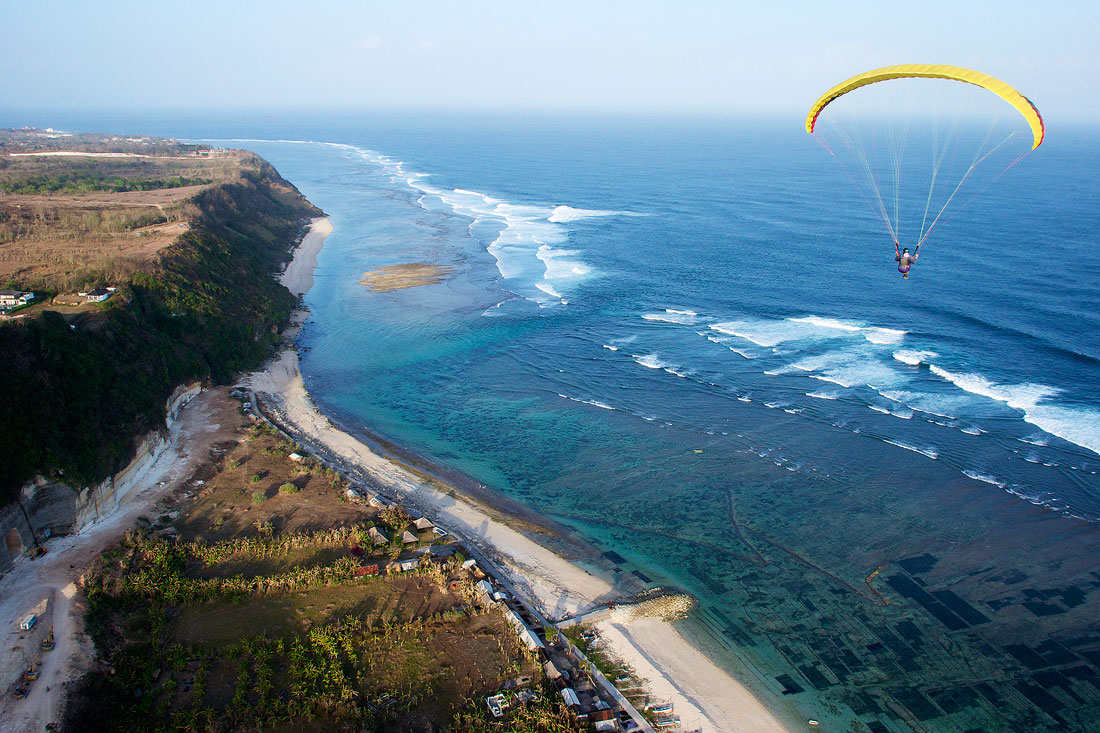By Kurt Kleiner
No one is exactly sure who invented the sport of paragliding.
However, there are photographs and video footage of a group of skydivers flying their parachutes off of small hills in eastern Montana in the late seventies. At about this same time, a handful of climbers in the French Alps began to use ram-air skydiving canopies to make safe and efficient descents from peaks after ascending technical routes. These parachutes weighed only eight pounds, flew at 20 mph., and were able to glide about three feet forward for every foot of altitude lost. By the mid-eighties, people realized there was a whole new challenge in prolonging the distance and duration of such flights if one could find and loiter in areas of rising air like the hang gliders did.
With this challenge came many attempts to improve parachute glide performance by using non-porous fabric, increasing the wingspan, and modifying the shape and trim of the airfoil. As each new design was tested, unexpected changes in the flight characteristics often appeared which demanded different pilot skills and techniques. Ideas which worked well were produced in large numbers to meet the demands of a growing population of paraglider pilots. The sport was well-established in Europe by 1986.
For several years, a wide range of equipment was developed in the US, Europe, and Asia. A few gliders with very dangerous flight characteristics were hastily distributed in the international market while other manufacturers conducted thorough tests with pilot safety in mind. In the US, at least three manufacturers of skydiving equipment were involved in developing and marketing paragliders which were extremely safe and stable, but which lacked the performance of the European designs. Since then, all three have returned their attention exclusively back to the skydiving market, primarily for economic reasons. By the early nineties, there were fewer radical new designs emerging, and production was concentrated on paragliders with very stable handling characteristics for the general flying population. Distinctions emerged among wings intended for students, intermediate/recreational pilots, and competition pilots. Standardized procedures for testing and certifying paragliders were established in France and Germany which now represent the benchmark for manufacturers around the world. Today, there are few pilots willing to fly an uncertified glider, and there are many regulated flying sites where the French or German certification is required. It is interesting to note that, although paragliders evolved from ram air skydiving parachute technology, the two sports have not completely diverged. In fact, they have begun to come full-circle in some regards. There are presently several sport jumping canopy designs emerging which have non-porous fabric, elliptical shaped wings, and thin-profile airfoils which allow for higher speeds, better glide performance, and greater aerodynamic efficiency. These features, which were developed for paragliders, are now being incorporated back into skydiving parachutes. Beware that, even though paragliders may look similar to some skydiving canopies at first glance, they have very different flight characteristics which require completely different pilot technique. Proper instruction is an absolute must, even for a hang glider pilot or a highly experienced skydiver. A student paraglider pilot spends hours learning how to ground-handle and launch a wing in different wind conditions. There is also a variety of procedures for managing the dynamic changes in flight characteristics which commonly occur when paragliders are flown in turbulent air. Understanding what is taking place and practicing the appropriate response under the direction of an instructor is essential for pilot safety.
In addition to learning how to launch, land, and control a paraglider in flight, a student spends considerable time studying meteorology on both the large and small scale. For example, it is critical to understand the effect that terrain features have on the movement of air. It is also important for pilots to know how changes in cloud conditions, atmospheric stability, and even the time of day can dramatically influence the outcome and safety of a flight. Considering the complexity of the weather, it’s no wonder that even the most experienced pilots feel they are in a constant state of learning throughout a lifetime of soaring.
The most important requirement for safe and successful paragliding is a proper attitude and good judgement. A pilot flying the most stable glider on the market, off the safest hill on the planet, and in a calm wind is not guaranteed a safe flight if concentration is lost, poor decisions are made, or a complacent attitude prevails. When learning to fly, listen carefully to your instructor and other pilots. Read what is recommended and then more. Pay close attention to what you are doing and double check all your equipment before launch. Spend considerable time studying the clouds and the wind speed and direction for changes, trends, and cycles. Watch how these changes affect the flights of other pilots. Once you are skilled enough to earn a pilot certification and fly on your own, don’t let the learning stop. Review emergency procedures frequently in your mind and always leave yourself a “way out” should the conditions of your flight change. Do not be in a hurry to buy high performance equipment. Allow yourself a couple hundred hours to experience different conditions and fly at different sites before complicating your life with equipment that requires more attention and quicker responses than you can provide as a novice. While in the air, know where all the other gliders are at all times. Constantly think and plan ahead. You must be in control of the glider, not vice versa. Most of all, trust your instincts. Don’t fly if something doesn’t feel right. There is much truth to the old saying that it’s better to be on the ground wishing you were in the air than to be in the air wishing you were on the ground. Respect the weather and what it can do. Have fun and let’s be careful out there.
